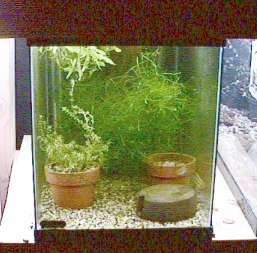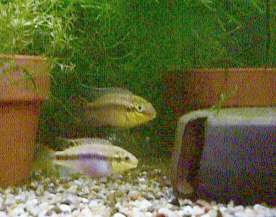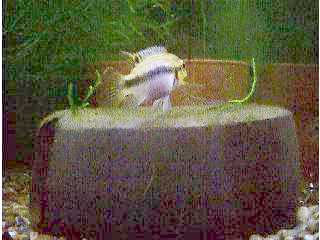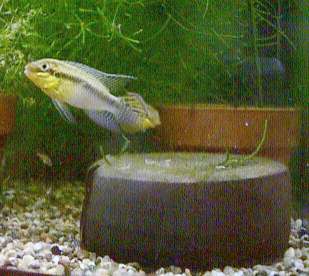
Amidst a small rack of tanks sits a ten gallon tank. Swimming about in a somewhat furtive manner is a pair of garishly colored cichlids, Pelvicachromis subocellatus.
The tank is decorated with a few potted plants along with a large clump of java moss, which provide some hiding spots and seem to make the fish feel comfortable--The male swims around the perimeter of the tank and often hovers above the small air pump driven sponge filter bubbling gently in the back of the tank. The female is swimming about the tank as well, and can often be seen around the small clay cave towards the front of the tank.

They gather together expecting to be fed when the tank is approached, and dine hungrily on the mixed diet they receive including at different times flakes, softened pellets, or frozen bloodworms. The male is a little over two inches long and the female is slightly smaller, maybe two thirds his length. They have spawned successfully two times during the four months they have been together in the tank. The water is a gentle 80 degrees Fahrenheit and is pleasant to the touch. The pH, though rarely checked, is around 6 with the water being soft (approximately 50ppm total hardness).
Amongst the java moss swim a couple of fry that missed the net during the last transfer to the fry tank. They dart cautiously about, eating at odds and ends in the java moss and ready to dive deep into the vegetation at any alarm. The next tank over in the rack is another 10 gallon tank containing the fry from the previous spawn who still swarm together even without the protective presence of the female.


The female is currently minus the striking black spawning coloration that occurs behind her head and towards the tail, framing her glowing pink belly. The small clay cave serves as the spawning site for the pair. When courting, the female will first be seen inside the cave picking at the walls as she prepares it for spawning. She will then aggressively twitch and thrust herself in front of the male to entice him to spawn. If the male is responsive the pair will take turns entering the cave to lay and fertilize the eggs. After spawning has occurred the female will stay in, or close to, the cave. Approximately a week later the wigglers have become capable of following her about and she will bring them out into the open for the first time. During the period following spawning the male can be seen patrolling the perimeter to guard off any invaders. The new parents will now spend their hours herding and leading their babies about the tank, often dining on the newly hatched brine shrimp that appear periodically in the tank.
The 40 watt fluorescent bulb that hangs above the rack turns off to the click of the timer and the fish fade from sight.